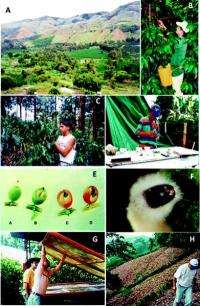An integrated pest management program for coffee berry borer in Colombia

The coffee berry borer, Hypothenemus hampei (Ferrari), is considered one of the most serious pests in coffee plantations worldwide. Infestations of this small beetle are difficult to combat; most of the insect's lifecycle is completed inside coffee berries, making insecticide penetration and contact difficult. Female beetles bore holes into developing berries attached to the tree through the blossom scar and create 'galleries' where they remain and deposit their eggs. The developing larvae feed on the bean or endosperm of the seed, reducing yields as well as the quality of coffee and its price.
In "Implementing an Integrated Pest Management Program for Coffee Berry Borer in a Specialty Coffee Plantation in Colombia," a free, open-access article appearing in the Journal of Integrated Pest Management, the authors discuss efforts to implement an integrated pest management (IPM) program for coffee berry borer in the Huila region of Colombia.
Overall, the IPM program was considered successful because problems associated with insect damage on the coffee crop decreased, despite reductions in endosulfan/chlorpyrifos use, which declined from 250 liters in 2002 to 75 liters in 2003, and 0 liters in 2004.
Harvest workers improved their efficiency at removing potential coffee berry borer breeding sites (leaving only 6.5 mature berries per tree in 2004, down from 22.2 in 2002), and the quality of parchment coffee beans increased, whereas the proportion of the harvest sold as high quality 'specialty' coffee increased from 50% to 86% over the same period.
This case study provides evidence that coffee berry borer potentially can be controlled using an integrated approach with minimal input of broad-spectrum insecticides. However, establishing and maintaining an effective IPM program for coffee berry borer is not a straightforward task. Some general recommendations arising from this case study include the need to convince the owners and managers of the coffee farm of the benefits of an IPM program, given the investment needed.
More information:
Provided by Entomological Society of America















